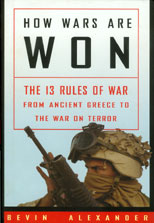 Click here to purchase from Barnes & Noble.
Click here to purchase from Amazon.com.
Click here to purchase from Barnes & Noble.
Click here to purchase from Amazon.com.
Rommel’s Recipe for Success in Africa
Excerpt from How Wars Are Won: The 13 Rules of War—From Ancient Greece to the War on Terror, by Bevin Alexander, pages 174-75
Shortly after [German General Erwin] Rommel landed in Libya on February 11, 1941, he grasped the essential nature of desert warfare: everything depended upon mobility.
“In the North African desert,” he wrote, “nonmotorized troops are of practically no value against a motorized enemy, since the enemy has the chance, in almost every position, of making the action fluid by a turning movement around the south.”
Rommel discerned that desert warfare was strangely similar to war at sea. Motorized equipment could move at will over it and usually in any direction, much as ships could move over the ocean. Rommel described the similarity thus: “Whoever has the weapons with the greatest range has the longest arm, exactly as at sea. Whoever has the greater mobility can by swift action compel his opponent to act according to his wishes.”
The key to victory in the desert was the tank, whose armor could withstand most enemy fire, and whose guns could shatter unarmored or lightly armored vehicles. The British had concluded from these two factors that armored warfare would consist primarily of tank-on-tank battles.
But since German and British tanks were more or less comparably armed and armored, each side on average would destroy about the same number of enemy tanks as it lost itself. In other words, stalemate would ensue unless the British deployed many more tanks than the Axis. This, in fact, was the British plan, and they brought far more tanks into the field than the Axis, aiming to gain victory by overwhelming numbers.
Rommel recognized the British theory was correct, if one accepted the premise that armored warfare would consist of tank-on-tank battles. But with Hitler uninterested in Africa, Rommel knew he had no chance of matching British tank numbers. He decided to fight the war differently than the British expected, resolving to withhold his relatively few tanks until the final push or drive to gain a decision---and to find another way to destroy British armor.
He and other German officers had already discovered a weapon eminently suited for this purpose---the 88-millimeter high-velocity antiaircraft gun. In the 1940 campaign in France, German commanders found that this gun, designed to shoot down high-flying aircraft, could blast through 83-millimeters of armor at 2,000 yards, making it by far the most formidable antitank weapon on either side.
The Germans also had another weapon, the 50-millimeter antitank gun, a light and nimble piece that could penetrate 50-millimeters of armor at 1,000 yards. The 50mm gun could sometimes crack the 30mm and 40mm armor of the fast British Cruiser and Crusader tanks, but could break through the 70mm frontal armor of the slow “infantry” Matilda tank only at point-blank range.
With these two weapons, which he used in new ways, Rommel created a tactical system---based on the concept of sending guns after tanks---that virtually nullified the vast British superiority in tank numbers. And, since Rommel was extremely bold in his offensive movements, he used his fewer tanks to throw the British into precipitate retreat time after time.
<< More 'World War II' Excerpts << Back to top